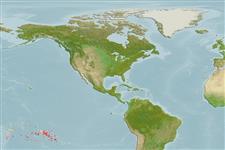>
Eupercaria/misc (Various families in series Eupercaria) >
Labridae (Wrasses) > Corinae
Etymology: Pseudojuloides: Greek, pseudes = false + Greek, iouis = a fish without identification, perhaps some of genus Coris cited by Plinius + Greek, oides = similar to (Ref. 45335); polynesica: Named for its type locality; noun in apposition..
Environment: milieu / climate zone / depth range / distribution range
Ecologia
marino associati a barriera corallina; distribuzione batimetrica 30 - 70 m (Ref. 116679). Tropical
Eastern Central Pacific: French Polynesia (Austral, Tahiti and Moorea, Society Is.); Tuamotu Arch. (Rangiroa); west to the Cook Islands and Line Islands at Kiritimati Atoll; excluding Marquesas Is.
Size / Peso / Age
Maturity: Lm ? range ? - ? cm
Max length : 12.0 cm TL maschio/sesso non determinato; (Ref. 89972)
Short description
Morfologia | Morfometria
Spine dorsali (totale): 9; Raggi dorsali molli (totale): 11; Spine anali 3; Raggi anali molli: 12. This species is distinguished by the following characters: D IX,11; A III,12; pectoral-fin rays 13; lateral-line scales 27 and +1 on caudal-fin base; head scaleless; gill rakers 14-17; one pair of large, projecting, and slightly recurved canine teeth anteriorly in each jaw, the upper pair is slightly out-flaring while the lowers curving forward and fitting between uppers when mouth closed; each side of upper and lower jaws with a short irregular row of 3-7 chisel-like incisiform teeth, no canine posteriorly at corner of mouth; body elongate, its depth 4.1-4.7 in SL; moderately compressed with body width 1.8-2.6 in body depth. Colour of female IP orangish to reddish to pink, grading to whitish ventrally, snout yellowish, the first two dorsal-fin spinous membranes black, edged distally with yellow-orange margin, median fins yellowish; while colour of TP male with greenish upper body and bluish lower one, a distinct mid-lateral blue stripe over green stripe along side of body; head yellowish above, blue below, with one blue stripe behind eye extending across operculum and usually dipping down to meet upper pectoral-fin base, upper snout yellowish with no stripes in front of eye; the first two dorsal-fin spinous membranes black; slightly rounded to truncate caudal fin with a prominent medial blue bar followed by a greenish or black area and a blue margin (Ref. 116679).
Life cycle and mating behavior
Maturità | Riproduzione | Deposizione | Uova | Fecundity | Larve
Victor, B.C., 2017. Review of the Indo-Pacific Pseudojuloides cerasinus species complex with a description of two new species (Teleostei: Labridae). J. Ocean Sci. Found. 29:11-31. (Ref. 116679)
IUCN Red List Status (Ref. 130435)
Threat to humans
Harmless
Human uses
Informazioni ulteriori
Nomi ComuniSinonimiMetabolismoPredatoriEcotossicologiaRiproduzioneMaturitàDeposizioneSpawning aggregationFecundityUovaEgg development
Age/SizeAccrescimentoLength-weightLength-lengthLength-frequenciesMorfometriaMorfologiaLarveDinamica popolazioni larvaliReclutamentoAbbondanzaBRUVS
BibliografiaAcquacolturaProfilo di acquacolturaVarietàGeneticaElectrophoresesEreditarietàMalattieElaborazioneNutrientsMass conversion
CollaboratoriImmaginiStamps, Coins Misc.SuoniCiguateraVelocitàModalità di nuotoArea branchialeOtolithsCervelliVista
Strumenti
Special reports
Download XML
Fonti Internet
Estimates based on models
Phylogenetic diversity index (Ref.
82804): PD
50 = 0.5000 [Uniqueness, from 0.5 = low to 2.0 = high].
Bayesian length-weight: a=0.00977 (0.00470 - 0.02030), b=3.07 (2.89 - 3.25), in cm total length, based on LWR estimates for this (Sub)family-body shape (Ref.
93245).
Trophic level (Ref.
69278): 3.4 ±0.4 se; based on size and trophs of closest relatives
Resilienza (Ref.
120179): Alto, tempo minimo di raddoppiamento della popolazione meno di 15 mesi (Preliminary K or Fecundity.).
Fishing Vulnerability (Ref.
59153): Low vulnerability (10 of 100).
